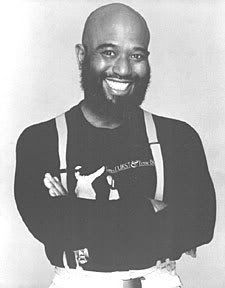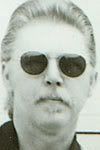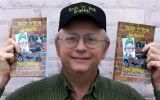
Josh White Jr.
By STEVE SEYMOUR
As a student at Bay de Noc Community College, I attended a pair of concerts which would have a lifelong impact, although I didn't know it at the time.
Occupying the old high school building on Escanaba's south side at this time, Bay didn't even have a place to hold a formal concert, yet plans were finalized to bring folk singer Josh White Jr., then on a tour of college campuses, to the Upper Peninsula.
Already, a quarter century of musical history surrounded White who was just 29 he appeared at the Escanaba high school auditorium on Feb. 25, 1970. His initial fame was traced to performing with his legendary father, Josh White, at Cafe Society, the country's first integrated night club. The boy also landed a role on Broadway, but continued to perform and record with his father for the next 17 years.
The elder White cast a long shadow. He was an acclaimed singer, guitarist, actor and social leader. White is recognized as the performer most responsible for introducing black folk, blues and gospel music to the white audience in America. He was unfairly blacklisted during the McCarthy era, but returned to prominence in the 1960s.
White suffered health problems as the decade wore on and died of heart disease on Sept. 5, 1969.
The younger White was prepared to continue on his own, schooled in American folk music by a master. Billed as a "total entertainer," White performed in Escanaba little more than a year after his father's death.
Guitar in hand, White put on an entertaining program, singing tracks from his newly released "The Josh White Album," on the United Artists label. Suitably impressed with White's knowledge of American music styles, it would be more than three decades before I saw him perform again.
Jim Lewis
Back at college the following fall, word spread about a blues show scheduled for Wednesday, Oct. 14, 1970. About 150 young people packed the student center to hear local residents Jim Lewis and Dave Lark deliver songs by the likes of Willie Dixon, Siegel-Schwall Band, John Hammond, B. B. King and Tom Rush, along with original material.
I was there to photograph the event for the Bay Beacon student newspaper. It was the first time I saw Lewis or Lark perform solo.
Lewis, or "Louie" as he was nick-named then, had just returned from a stint as a traveling bluesman. According to a poster from the period, Lewis "spent three years as a rambler, hitchhiking throughout the U. S. with no responsibilities except to himself. In his travels he attended many rock concerts and festivals including Ann Arbor Blues Fest, Bloomington Rock Fest, Milwaukee Rock Fest and weekly festivals which were held at Tartar Field in Detroit." Lewis further honed his chops performing at the University of Detroit, as well as Ann Arbor clubs The Ark and Mr. Flood's Party.
Young people were beginning to discover the music at the foundation of rock 'n' roll. The Ann Arbor Blues Festivals of 1969 and 1970 were the first such events in North America to feature modern Chicago-style blues. Featured were dozens of great contemporary blues players including James Cotton, Buddy Guy, John Lee Hooker, B. B. King, Lightnin' Hopkins, Magic Sam, Fred McDowell, Muddy Waters, Otis Rush, Son House, Hound Dog Taylor, Junior Wells and Howlin' Wolf. At 6 foot, three and 300 pounds, the physically and musically impressive Wolf was Lewis' inspiration.
Only 22 at the time of the Bay College show, Lewis was fully realized as a blues singer and guitarist. Perched on a stool, Lewis played some numbers his audience probably never heard before. The college crowd responded enthusiastically, perhaps realizing the artist had paid his dues, learning at the feet of the masters. Lark's set was also well received, at times drawing comparisons to Jimi Hendrix, the guitar great who died just a few weeks before.
So it was in 1970 that I attended two concerts which expanded the audience's exposure to blues and other American roots music whether by design or not.
Over the next decades I enjoyed many types of music in a concert setting, including seeing the folks behind those influential performances so many years ago.
At the turn of the millennium, Lewis increased his musical appearances, touring around the Upper Peninsula with the Shuffleaires which included "Big" Al Ek, Mary Corbett and Dan Stephens. Even in succeeding years when Lewis performed at 8th Street Coffeehouse in duos with Corbett or Jay Brodersen, his setlist was a virtual textbook of American blues and roots music.
The Lark Brothers Band, meanwhile, are equally informed in their choice of material, blues or otherwise and have played before a packed house at 8th Street more than once.
White, who lives in Detroit, returned to Escanaba for a coffeehouse gig as well. During the show, he carefully explained to the audience the intricacies involved with his father's performance of the traditional folk song "House of the Rising Sun," later made famous by The Animals.
Today I understand my appreciation of music would have been significantly diminished had I not attended two concerts at the dawn of the 1970s.


 I've enjoyed rock music and writing since I was a teenager in the 60s. I feel lucky to have been around when rock's greatest stars created their most enduring hits. At the same time I found I enjoyed writing, as well. I worked on my high school newspaper and magazine, was editor of several college publications and earned a bachelor's degree from Central Michigan University in 1973. I worked for the daily newspaper in my hometown after graduating, becoming managing editor after a few years. By the 1980s, I moved into public relations. In 1985, my wife Sue and I opened a retail music store, The Record Rack, which we still own. Rock 'n' roll has been integral to me and for the last 2O years I've been earning my living from it even though I don't have a musical bone in my body. In recent years, I've also I edited a small local magazine and launched a micro FM radio station. Now, I'm finally combining my love of writing and rock 'n' roll. I can't sing a note, but I know what I like. I'll tell you all about it when you read on. I hope you have as much enjoyment reading these installments as I've had writing them.
I've enjoyed rock music and writing since I was a teenager in the 60s. I feel lucky to have been around when rock's greatest stars created their most enduring hits. At the same time I found I enjoyed writing, as well. I worked on my high school newspaper and magazine, was editor of several college publications and earned a bachelor's degree from Central Michigan University in 1973. I worked for the daily newspaper in my hometown after graduating, becoming managing editor after a few years. By the 1980s, I moved into public relations. In 1985, my wife Sue and I opened a retail music store, The Record Rack, which we still own. Rock 'n' roll has been integral to me and for the last 2O years I've been earning my living from it even though I don't have a musical bone in my body. In recent years, I've also I edited a small local magazine and launched a micro FM radio station. Now, I'm finally combining my love of writing and rock 'n' roll. I can't sing a note, but I know what I like. I'll tell you all about it when you read on. I hope you have as much enjoyment reading these installments as I've had writing them.


No comments:
Post a Comment